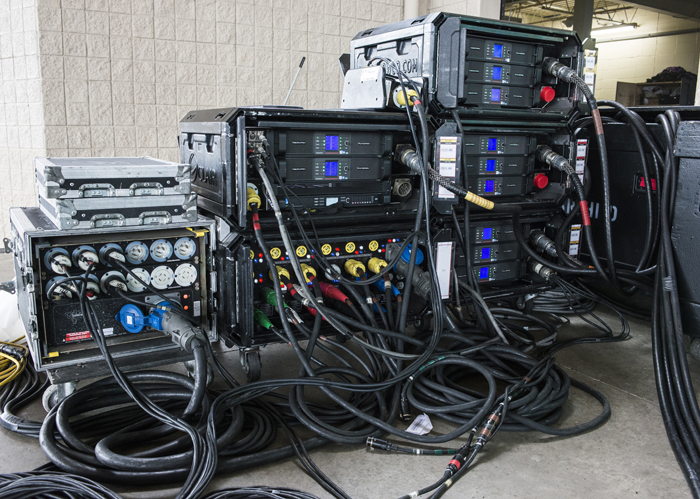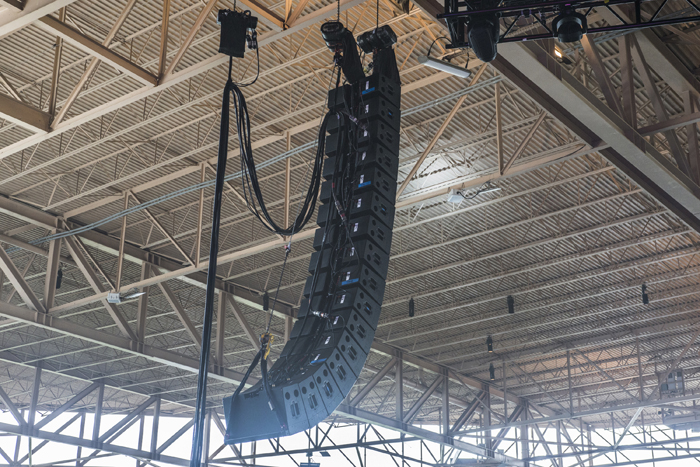Formed in 2012, Fifth Harmony has quickly risen to major touring status backed up with impressive recording sales success. The all-female pop/R&B group, currently out on the 7/27 Tour of the U.S., Europe, and South America in support of the latest album of the same name, is visiting both arenas and amphitheatres, with sound reinforcement provided by Clair Global (Mannheim, PA) and a veteran live audio team.
Front of house engineer Matt Lawrence is mixing on a new Allen & Heath dLive S5000 control surface, and it’s joined by a DM64 MixRack providing signal distribution and routing.
He’s working with the high-intensity group’s five distinctive vocals as well as a three-piece live band and precisely timed recorded tracks, feeding a main PA under the direction of systems engineer/audio crew chief Anson Moore that’s headed by Clair i3 full-range line arrays and CP-218 dual 18-inch subwoofers on the deck, all driven by a Lab.gruppen/Lake power/control package.
The tour is appearing at both indoor arenas and outdoor pavilions of varying sizes, and with occasionally challenging acoustics. The situation keeps the audio team on its toes in adapting to both the varying acoustics from show to show as well as less-than-typical FOH locations at certain venues.
I recently caught up with Lawrence and Moore to discuss their work on the tour, which is also supporting two opening acts each night utilizing the same console and house system. Moore mixes one of these acts, with a guest engineer handling the other.
Where It Starts
Lawrence begins by noting that some of the venues the tour’s visited, such as the Dunkin Donuts Center in Providence, RI, have excellent acoustics. In contrast, Boston’s Blue Hills Bank Pavilion presented an architecturally complex, tent-style roof that threatened multiple, swirling echoes, which Moore was able to overcome by carefully aiming the main arrays away from the roof and towards the audience.
Still other venues, like the Meadow Brook Amphitheater in Rochester Hills, MI present challenging FOH locations. On that particular outdoor show, for example, Lawrence was positioned about 250 feet from the stage in a cramped wooden enclosure, with compact Clair loudspeakers flanking his mix surface, deployed as left-right “near-field monitors” to provide additional clarity to what he was hearing.
Fifth Harmony’s five vocalists, who perform extensive choreography throughout each show, employ Shure UHF wireless handheld transmitters outfitted with BETA 58A supercardioid dynamic capsules. “The vocalists have learned how to use the mics well, and the handhelds help me avoid phasing problems and frequency buildup I’ve had with headsets on tours with other groups,” Lawrence explains.
He notes that the group’s previous tour shows were solely backed by recorded tracks, which left him riding herd over just a dozen console faders. Things are a bit more complicated now, largely because this time out, there’s also the band that’s comprised of a keyboard player, guitarist and drummer.
Band instruments are handled with both wired mics and direct feeds for things like the one mono and two stereo keyboards. Five channels for the recorded tracks bring the total to 32 sources plus three spares, with all sources feeding the dLive mix system as well as monitor engineer Kyle Borman’s Avid VENUE digital console. Splits are accomplished with a Clair analog splitter.

Lawrence adds that the tracks, cued by Borman from his monitor position, are well-recorded. They’re joined by a click track in Borman’s in-ear monitor mixes to the performers to help keep them in sync, feeding JHA Audio JH16 earpieces via Shure PSM 1000 personal monitoring systems. Clair monitor tech Jordan Turner is handling all wireless frequency management on the tour.
For his part, Lawrence likes that the tracks remain consistent at every show, and he uses the same dLive EQ, level and compression settings to blend them with the other sources in a way that they become a natural part of the show and indistinguishable from the live sources, calling them “a very consistent MIDI instrument” that help promote “unity for my mix.”

















